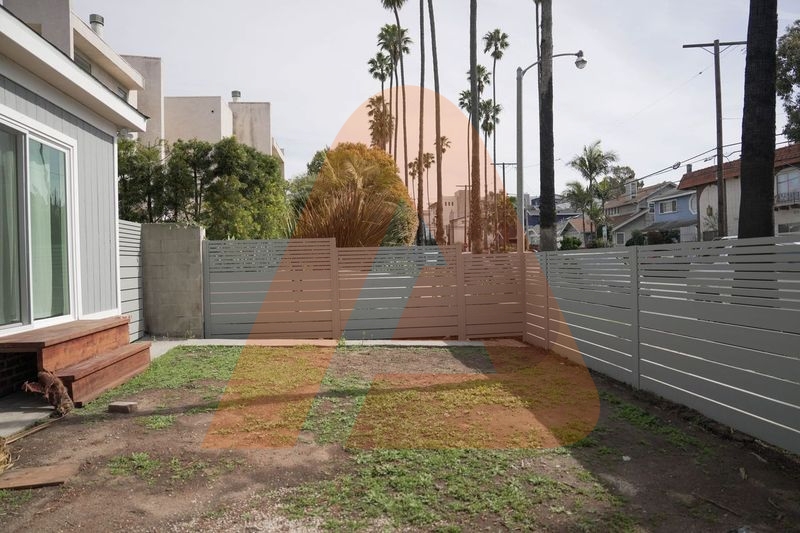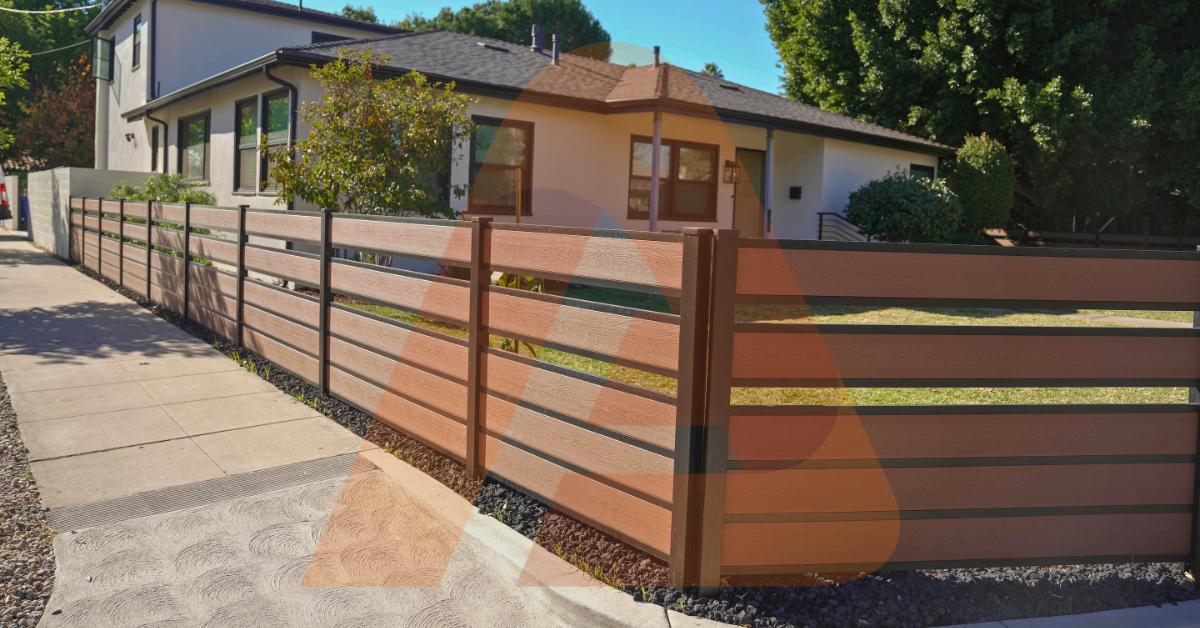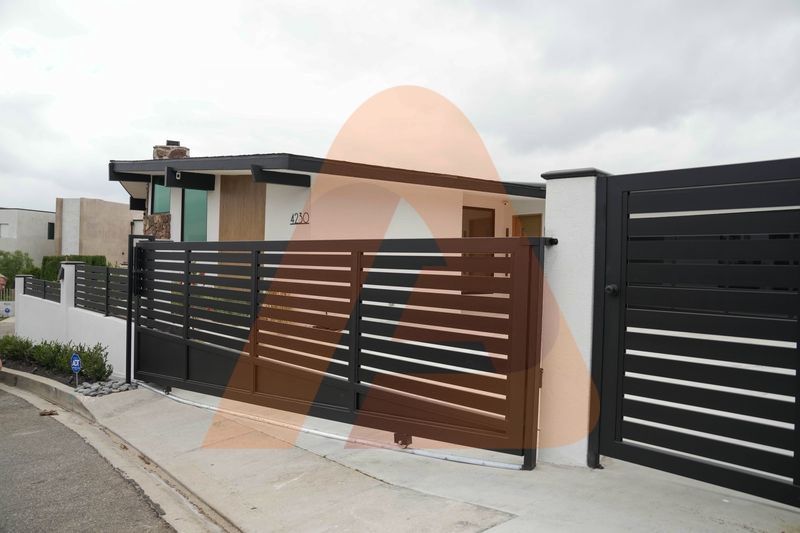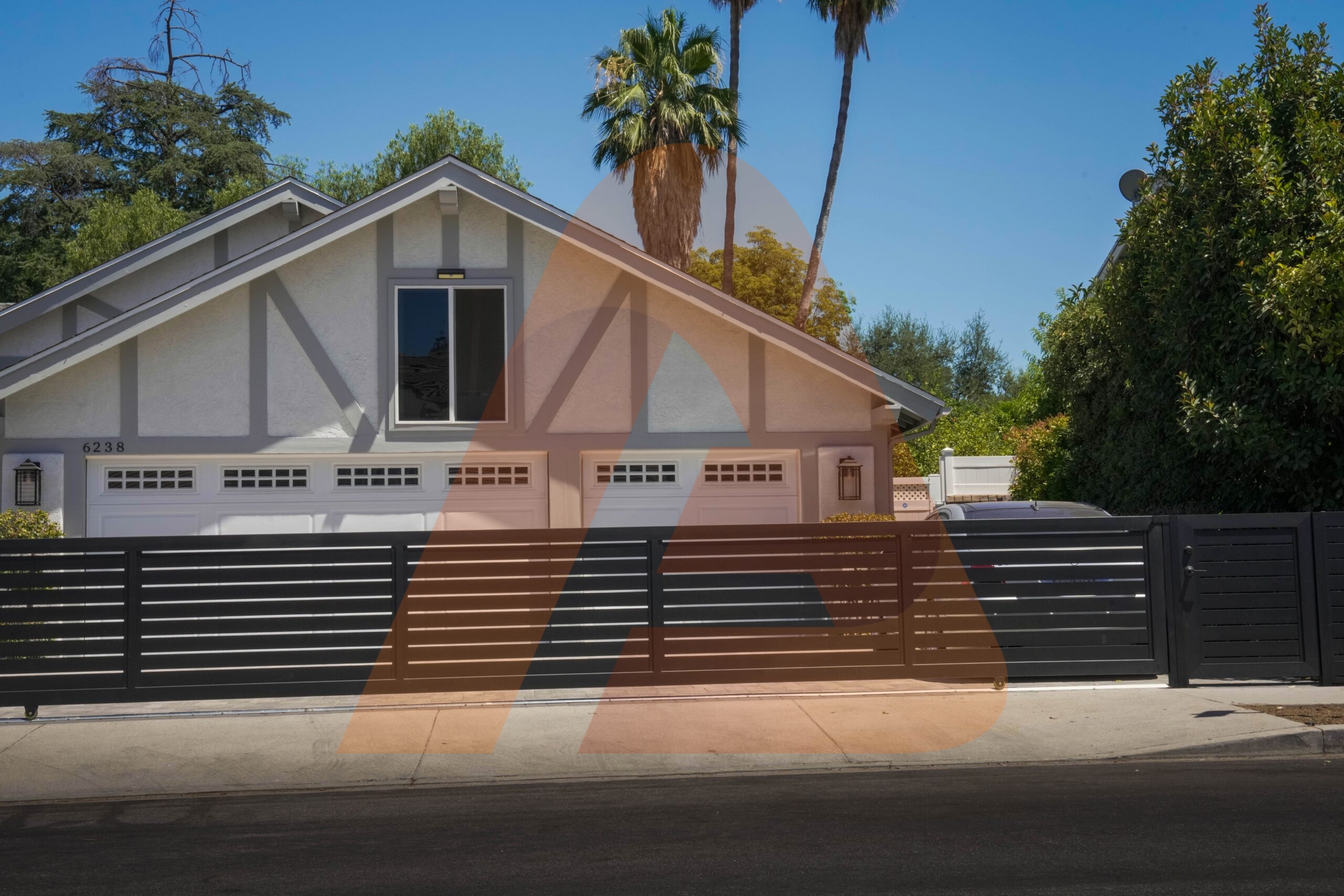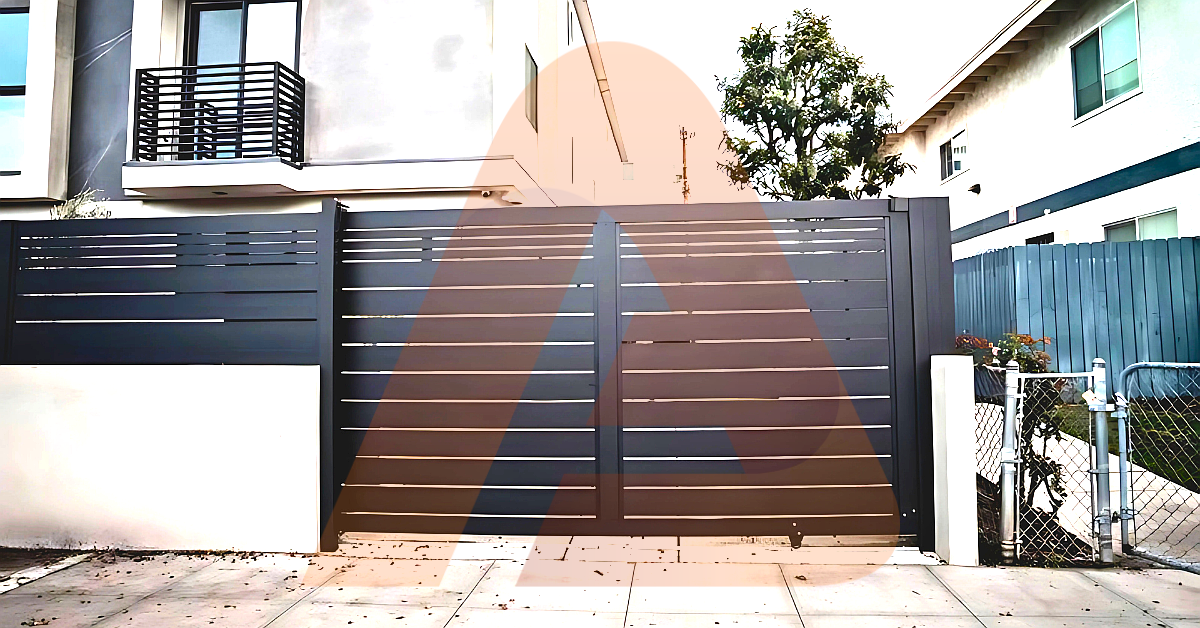
Elegant Gate Designs That Complement Chino Hills Mediterranean-Style Homes
- By alupost
- Posted on
Table of Contents
Elegant Gate Designs That Complement Chino Hills Mediterranean-Style Homes
Chino Hills has become one of Southern California’s most desirable residential areas, where Mediterranean-style homes with terracotta roofs, arched entryways, and elegant stonework define local architecture. For homeowners aiming to elevate their property’s first impression, gates play a defining role. The right gate design doesn’t just mark your boundaries—it enhances the home’s overall aesthetic harmony and boosts real estate value. Modern homeowners in Chino Hills now prefer gates that blend traditional Mediterranean charm with contemporary convenience. This approach creates a seamless connection between architecture and function, with emphasis on elegance, durability, and craftsmanship. By choosing carefully designed gates from premium materials like wrought iron or aluminum, homeowners achieve an entrance that reflects sophistication, privacy, and timeless appeal.
Classic Mediterranean Gate Characteristics
Mediterranean gates typically feature ornate scrollwork, soft curves, and warm metal finishes that echo the rustic details found in architecture across Spain, Italy, and Greece. In Chino Hills, where Mediterranean-style homes are often surrounded by lush landscapes and terraced gardens, these gates reinforce an authentic old-world atmosphere. Many local homeowners incorporate bronze-toned metalwork or hand-forged patterns that mimic vintage craftsmanship, creating continuity between the gate design and tile-roofed facades. A signature characteristic of Mediterranean gates lies in their balance between openness and security—iron bars and filigree patterns provide transparency while symbolically connecting your outdoor surroundings with your private space. Custom designs can also include decorative motifs inspired by sunbursts, vines, or geometric latticework, making each gate a distinct addition to the property’s architectural personality.
Modern Upgrades that Maintain Mediterranean Charm
While Mediterranean style values elegance and artistry, today’s homeowners in Chino Hills are also embracing technology for convenience and security. Automated gate systems with discreet motors and smart entry controls allow seamless access without compromising the gate’s decorative appeal. For example, wrought iron gates can be powder-coated in matte finishes that resist weathering, while maintaining a handcrafted look. Meanwhile, aluminum gates designed to replicate the depth and detail of traditional iron offer reduced maintenance requirements and lighter weight for smoother operation. Integrating warm LED lighting that highlights the gate’s ornamental details further enhances nighttime curb appeal, blending tradition with modern sophistication. Smart locks, intercom systems, and motion sensors can all be hidden within the Mediterranean framing so the gate maintains its authentic and graceful character while functioning as a dependable modern security feature.
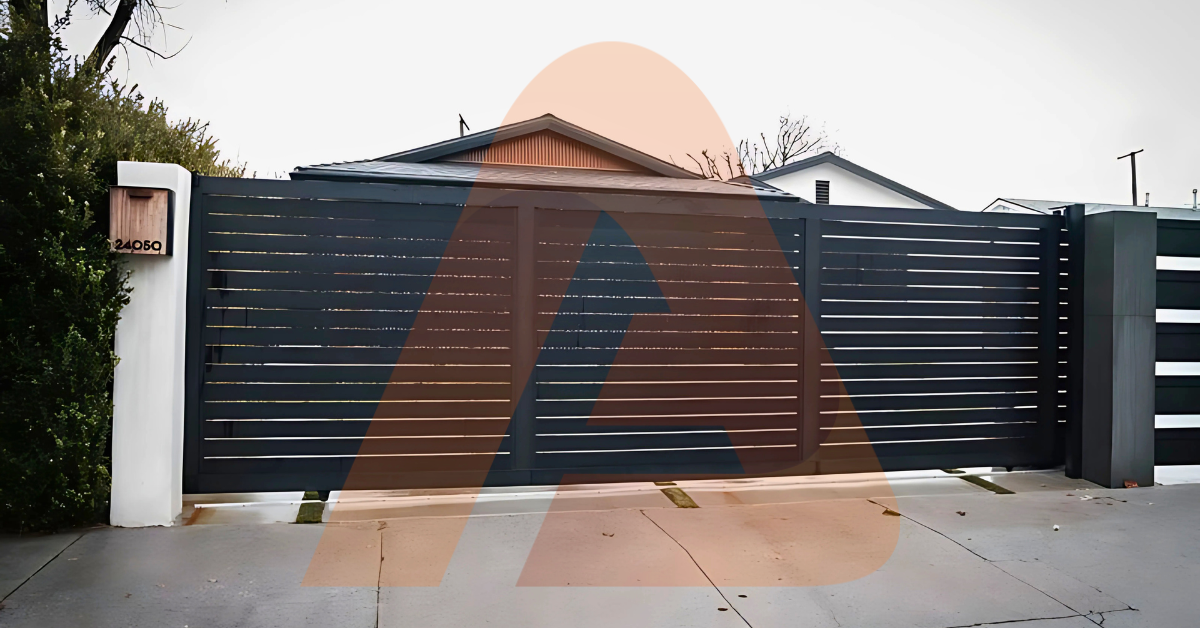
Materials and Finishes for Mediterranean Elegance
Selecting the right gate material and finish is essential to harmonize with Mediterranean-style homes in Chino Hills, where stucco facades, clay roof tiles, and arched motifs demand a gate that feels handcrafted yet endures local climate and HOA expectations; powder-coated aluminum stands out for its corrosion resistance, lighter weight for smooth automation, and the ability to replicate wrought iron scrollwork with laser-cut precision, while modern finishing systems provide deep bronze, oil-rubbed, and matte black tones that complement warm stucco palettes without frequent repainting, ensuring a refined look that resists sun fade across the city’s abundant sunshine days and low-humidity conditions typical of the region’s Mediterranean climate profile. Wrought iron remains a classic choice for old-world gravitas and ornate curves aligned with Italian and Spanish influences, especially for estates seeking substantial visual presence, but it requires vigilant coating integrity and periodic maintenance to deter oxidation in outdoor exposure; hot-dip galvanizing plus primer and powder coat can dramatically increase longevity, although total lifecycle upkeep skews higher than aluminum, a tradeoff many homeowners evaluate alongside HOA styling guidelines and the need for professionally submitted elevation drawings when projects interface with gated entries or neighborhood standards. For homeowners exploring hybrid aesthetics, aluminum frames with forged-look appliqués or mixed-material accents can deliver Mediterranean texture without structural weight penalties, while premium powder coats engineered for exterior use extend color retention and chip resistance, an advantage for automated systems where frequent motion stresses hinges and finishes; tying finish tones to existing bronze light fixtures, stone veneers, and balcony railings in neighborhoods across North Chino Hills and similar upscale pockets yields cohesive curb appeal that reads intentional from the street.
Powder-Coated Aluminum Advantages
Aluminum’s non-ferrous composition eliminates rust concerns outright, making it a practical standard for long-term installations that prioritize smooth operator performance, reduced motor load, and minimal service cycles; the lighter panels reduce strain on actuators, hinges, and rollers, which is especially beneficial in busy driveways and community entries where daily open-close counts are high, and modern powder coats deliver a hand-forged visual with finely textured matte finishes that emulate traditional patinas without the susceptibility to flaking common in painted systems. In practice, homeowners achieve Mediterranean authenticity through laser-cut vine motifs, soft-radius top rails, and spear-tip silhouettes rendered in aluminum, then finished in deep espresso bronze or weathered black to echo wrought iron, all while benefiting from improved colorfastness under Chino Hills’ sunny conditions and easier compliance with HOA requests for clean, uniform appearances; these builds pair seamlessly with concealed operators and discreet safety hardware, keeping the façade elegant and uncluttered.
When Wrought Iron Makes Sense
Wrought iron still earns its place for estates that demand heavy, tactile presence and intricate scrollwork with dimensional bar stock, enhancing arched porticos and stone pilasters typical of Mediterranean luxury; when specified with galvanizing, high-build primers, and quality powder coats, iron can deliver decades of service, though owners should budget for periodic inspection of joints, touch-ups, and sealing to keep oxidation at bay around welds and hardware interfaces where coatings are most vulnerable. This premium feel can be worthwhile for custom homes and gated neighborhoods that emphasize old-world craftsmanship, where submittals may include scaled elevations and setback details for gated entrances, aligning aesthetic goals with municipal considerations like turn-around access, equipment placement, and safety override requirements; in these contexts, iron’s visual authority supports the architectural narrative while compliant plans ensure smooth approvals.

Automation and Smart Access for Mediterranean Gates
Integrating automation into Mediterranean-style gates in Chino Hills elevates both daily convenience and architectural harmony, especially when operators are selected to remain discreet and whisper-quiet so they don’t distract from arched motifs, stucco textures, and stone-clad pillars; underground swing operators or low-profile linear actuators maintain clean sightlines, while brushless and 24V systems with battery backup ensure smooth motion and reliable cycling during power interruptions, which is critical for hillside properties and larger estates, and pairing these with soft-start/soft-stop control preserves hardware and paint finishes over years of use, reducing wear at hinges and latches as the gate gracefully opens and settles into a fully closed position without jolts that can fatigue decorative scrollwork or loosen fasteners in high-use driveways. For access control, homeowners typically choose a layered stack that begins with keypad or fob access for family, integrates intercom or video call panels for visitors, and extends to app-based remote control so gates can be monitored, scheduled, and serviced from anywhere; in Mediterranean neighborhoods where aesthetics matter, surface-mounted devices are often specified in oil-rubbed bronze or matte black housings to match the gate finish, and lighting can be tuned with warm LED accents that highlight arches and spear tips at night, while remote diagnostics and cloud connectivity enable technicians to adjust timers, obstacle sensitivity, and cycle counts without opening control boxes, keeping the entrance pristine and minimizing visible hardware.
Swing vs. Sliding for Chino Hills Lots
Swing gates align beautifully with Mediterranean façades because they echo the curvature of arched entries and work naturally between stone pilasters, but they require adequate inward swing clearance on sloped drives to avoid ground strikes and may need custom hinge offsets or stepped grades to maintain reveal lines; sliding gates solve tight setbacks and rising driveways by moving parallel to the fence line, often with concealed track or cantilever designs that preserve visual flow, and modern controllers with adaptive torque maintain smooth travel even as seasonal dust or debris accumulates along the path, which is common in foothill neighborhoods and view lots. For homes with grand, double-leaf swing entries that frame a Mediterranean courtyard, specifying synchronized dual operators keeps both leaves aligned and closing uniformly against a center stop for a stately arrival experience; where side yard space allows, a single-piece sliding gate can hide behind hedges or stucco walls, and brushless motors with intensive duty cycles handle frequent opens for multi-vehicle households while keeping noise minimal in quiet residential streets.
Safety, HOA, and Aesthetic Compliance
Safety features should be designed into the architecture from day one: photo eyes positioned at appropriate heights to detect vehicles and pets, edge sensors on leading edges, and properly set obstruction thresholds to prevent damage to ornate metalwork; timed auto-close, pedestrian modes, and manual release procedures should be documented for residents and service providers, ensuring the system remains both elegant and inherently safe, particularly important in family neighborhoods and gated pockets across Chino Hills that value serene streetscapes and responsible operation standards. Many communities and custom-home enclaves expect submittals that include gate elevations, equipment placement, and lighting plans, so coordinating finishes, operator concealment, and accessory colorways with Mediterranean palettes increases approval success; choosing fixtures that echo balcony rail tones and specifying low-glare lighting preserves the warm, old-world feeling while meeting modern access expectations, a balance that keeps property value high and neighborhood cohesion intact.
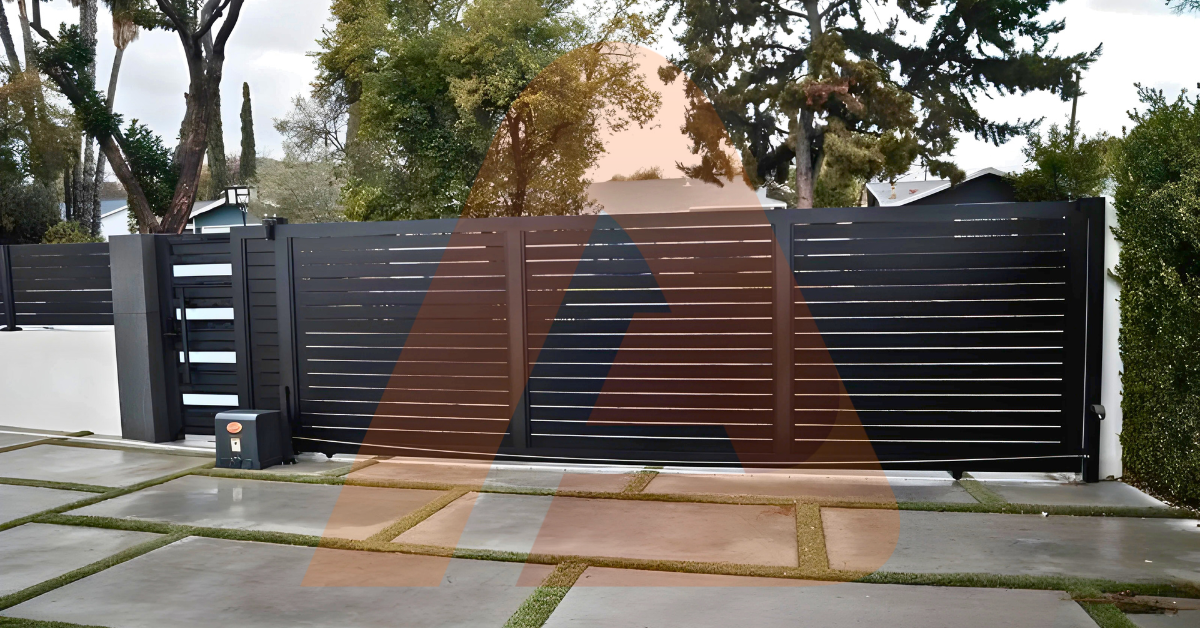
Color Palettes and Architectural Harmony
Coordinating gate colors with Mediterranean architecture in Chino Hills starts by echoing the warm, earthy palette found in stucco, clay roof tiles, and natural stone, which means favoring deep bronze, oil-rubbed black, espresso, and textured charcoal that read as timeless against sunlit façades and hillside backdrops; these tones provide a grounded, handcrafted feel that aligns with arched entries and wrought-iron balconies, while slightly matte or sand-textured finishes minimize glare and help the gate appear integrated rather than add-on, especially important in neighborhoods where curb appeal is judged from longer approach roads and elevated lots that frame the home’s silhouette against bright skies common to the area’s Mediterranean climate profile. For accent strategy, repeat metal tones from lighting, window grilles, and railings so the eye connects architectural details into a coherent whole; pairing a rich bronze gate with warm LED uplights creates depth at night without breaking the old-world mood, and where stone pilasters lean cooler, a graphite or aged-iron finish can bridge cool undertones while preserving the Mediterranean character, yielding a refined entrance that remains elegant through seasonal shifts, Santa Ana wind periods, and long summer days.
Texture and Patina Strategies
Mediterranean gates benefit from finishes that simulate artisanal metalwork, so specifying fine-texture powder coats or light hammer-tone effects adds visual depth that hides micro-abrasions from dust and wind, while helping scrolls, spears, and arched profiles cast richer shadows along stucco walls throughout the day; these tactile surfaces feel authentic and reduce maintenance visibility, an advantage when exposure to sun and occasional dry winds can highlight imperfections on glossy coats, making textured matte the safer long-term aesthetic choice for prominent frontages. For homeowners who love patina, choose controlled, factory-applied bronze or aged-iron effects instead of raw weathering so the look remains stable under UV and temperature swings typical of the inland valleys, and coordinate any gilded or copper highlights sparingly at rosettes or knuckles to avoid visual clutter; this selective approach supports the architecture’s dignity while giving the entrance a bespoke signature that reads upscale from the street and at close inspection.
Color Planning for Slope and Sun
Chino Hills’ warm, dry summers and mild winters mean prolonged sun exposure that can amplify color shift if pigments aren’t selected carefully, so prioritize exterior-rated, UV-stable finishes with darker neutrals that resist noticeable fade and keep the ensemble cohesive with roof and façade tones over time; situating the gate where afternoon sun strikes hardest may warrant slightly cooler darks like iron gray to balance warm stucco at peak light, maintaining contrast and definition from the curb through seasonal daylight changes. On sloped drives and view lots, gates are often seen from multiple angles, so ensure color continuity on both faces and the frame edges, and extend the chosen tone to visible hinges, caps, and latches for a seamless presentation; matching accessory housings and conduit paint to the gate color further reduces visual noise, preserving the Mediterranean calm and making the entrance feel designed as part of the architecture rather than as an afterthought.
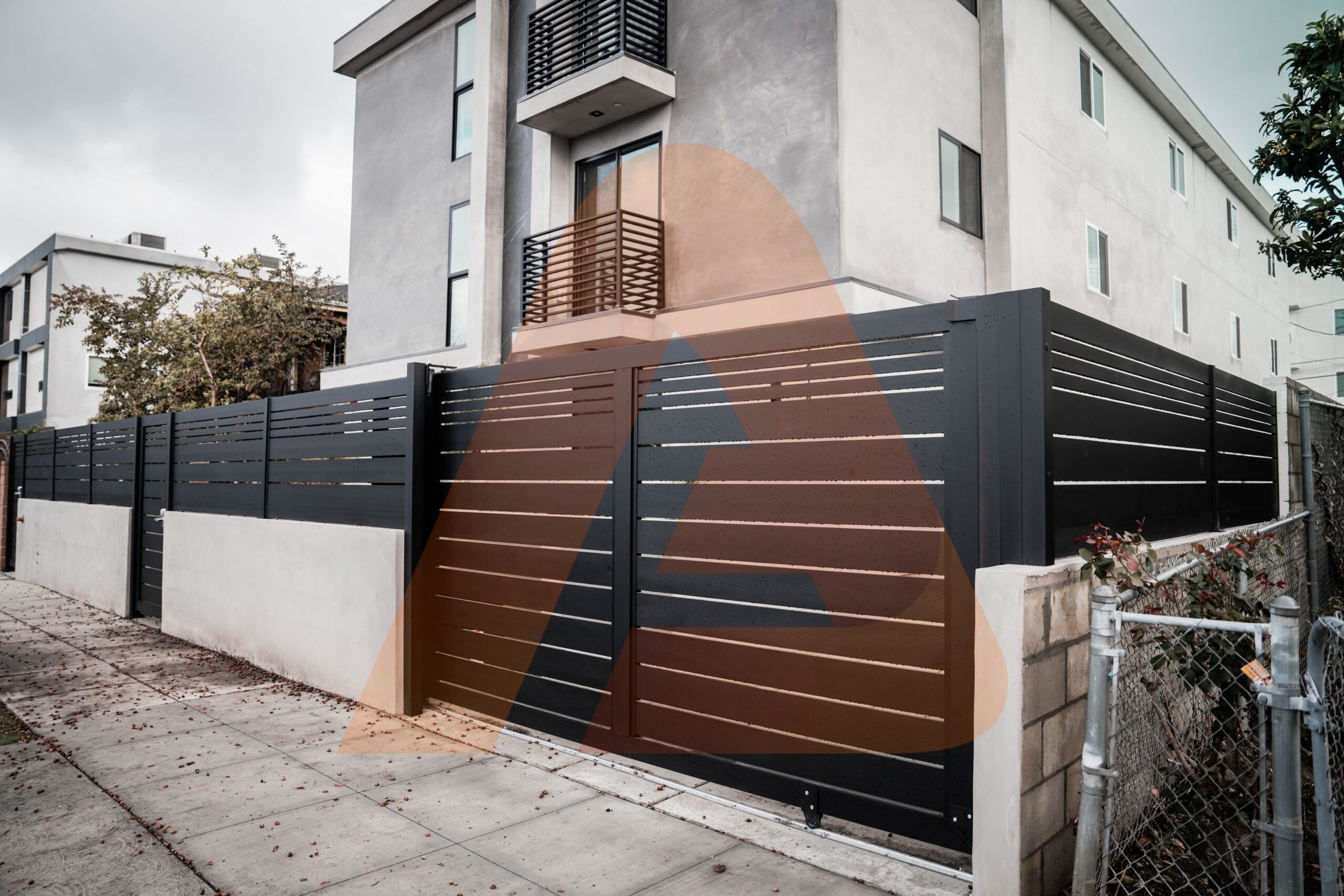
Gate Layouts for Mediterranean Curb Appeal
Designing the gate layout to match Mediterranean architecture in Chino Hills begins with proportion and symmetry: double-leaf swing gates framed by stucco or stone pilasters feel native to arched entries and terracotta rooflines, while gentle arch-top silhouettes echo doorways and window transoms to create a cohesive rhythm from street to courtyard; placing the hinge-to-post reveal tight and aligning the top rail curve with the arch of the entry portal produces a continuous visual gesture that reads as intentional, and setting the gate plane slightly forward of landscaping allows vines and olive or citrus plantings to soften the metalwork without obscuring it, preserving both presence and texture under the area’s warm, dry summers and mild winters typical of a Mediterranean climate. Drive approaches in hilly streetscapes should anticipate turning radii and grade changes so vehicles don’t clip leaf edges; on rising driveways, specify upward-offset hinges and ensure bottom rail clearance to prevent ground strikes, and consider a deeper setback for a comfortable stacking zone inside the property line, which improves guest flow and keeps the façade composed even during busy arrivals on bright, high-UV afternoons common to inland valleys.
Courtyard, Pedestrian, and Service Access
Mediterranean homes benefit from layered entry sequences, so pairing the primary driveway gate with a matching pedestrian gate maintains scale and daily usability without cycling the main operator for quick foot traffic; integrating the walk gate into a pilaster or low stucco wall keeps the massing authentic, while repeating spear tips, knuckles, and scrolls ensures the smaller opening feels like part of a curated ensemble rather than an afterthought, and using the same powder-coat family across hinges, latches, and hardware sustains a quiet, unified look under strong sunlight and seasonal Santa Ana winds. For discreet functionality, add a side yard service gate that mirrors the main design in a simplified pattern to preserve hierarchy—fewer scrolls, same color and texture—so waste, gardening, and deliveries route cleanly without disturbing the formal frontage; this hierarchy keeps the architecture’s dignity intact while improving daily flow around the property and minimizing visible wear on the primary entrance components.
Landscaping, Lighting, and Sightlines
Plantings and lighting should frame, not fight, Mediterranean gates: place low water-wise shrubs and neatly trained vines so scrolls and arches cast legible shadows on stucco, using warm LED uplights at pilasters to graze stone textures and reveal handcrafted details at night without glare, which is crucial given the bright, dry conditions and occasional dust that can make harsh light feel clinical; aiming for 2700–3000K color temperature maintains an inviting, old-world warmth that pairs naturally with bronze and iron tones. Preserve sightlines through careful trimming along approach curves so the gate remains visible from multiple angles on sloped lots, maintaining safety and elegance as drivers approach; continuity of finish on the gate’s back face and posts matters because elevated streets often expose both sides to view, and consistent presentation across all vantage points reinforces the refined, resort-like impression that Mediterranean neighborhoods in the inland valleys strive to maintain year-round.
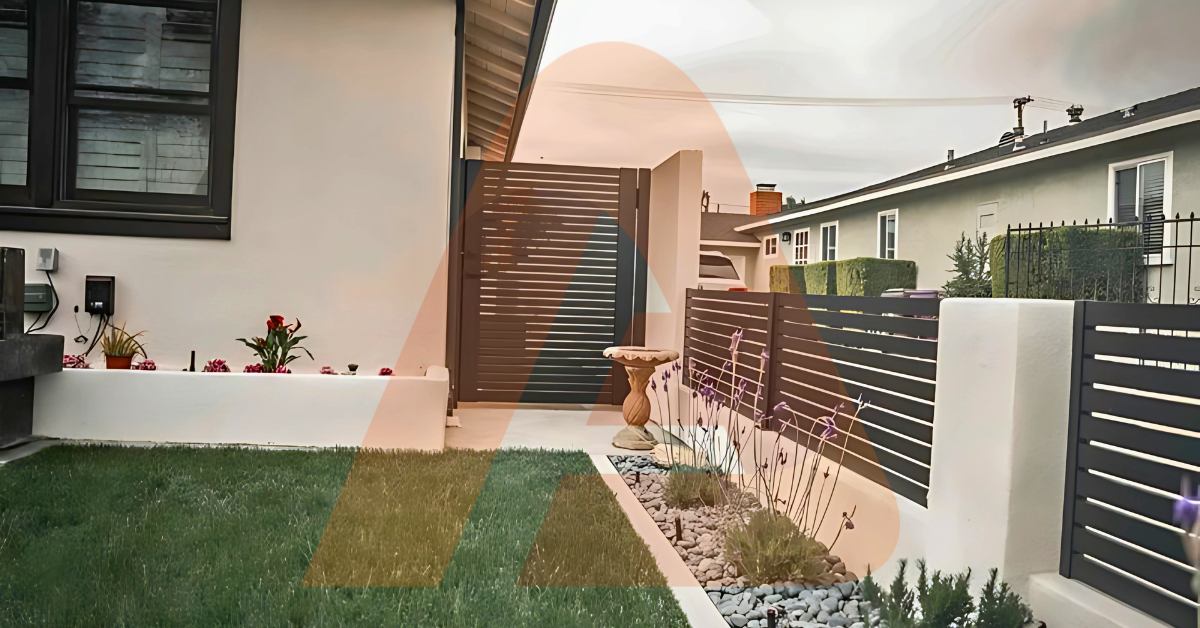
Design, Style, and Gate Pairing
A successful horizontal privacy fence in Scottsdale starts with an intentional design language that flows from street frontage to backyard living spaces, which means committing to a slat rhythm that aligns with the home’s architecture—tight, uniform spacing for minimalist desert-modern facades or mixed-width courses for a crafted, boutique feel—while carrying that rhythm across long runs with consistent top lines, perfectly aligned seams, and concealed fasteners so the assembly reads as one continuous architectural element rather than a collage of panels, and then selecting a finish palette that balances heat and glare control with visual warmth, favoring matte blacks, bronzes, and earth tones that sit comfortably alongside stucco, stone, and xeriscape while reducing dust visibility, with edge trims and caps that frame the silhouette cleanly, sound-dampening details at gates to eliminate rattle in afternoon winds, and careful alignment at grade transitions to keep sightlines calm and level from the curb and patio alike even as terrain steps or subtly rakes.
Gate layouts that feel custom
Gate planning should mirror the fence’s geometry with frames that maintain the same slat rhythm, rail reveals, and finish so openings feel integrated rather than afterthoughts, which begins by placing walk gates where foot traffic naturally flows and sizing them for comfortable passage and hardware swing arcs, then coordinating driveway gates to echo the fence’s proportions with reinforced hinge posts, properly rated hinges and latches for high-UV, dusty conditions, and soft-close or automated operators where convenience and quiet operation are priorities, all while maintaining the top-line continuity across the fence-to-gate transition, tucking conduits for lighting or operators inside posts or under caps to hide runs, and setting thresholds slightly above grade so water, grit, and decomposed granite don’t bind hardware after monsoon splashback or irrigation cycles.
Finishes, accents, and lighting
Finishes should prioritize UV-stable, low-sheen coatings that mute reflection and heat while preserving rich, even color across seasons, with aluminum or steel frames powder-coated to resist chalking and wood or composite slats finished in breathable, UV-inhibiting products that slow color shift and reduce surface checking, and accents should be restrained and purposeful—think slim top caps that sharpen the profile, color-matched fasteners that disappear visually, and metal edge trims that protect slat ends—while integrated low-voltage lighting can wash the horizontal lines with soft, indirect glow from beneath caps or within post cavities, elevating nighttime ambiance without exposing wiring or hardware, and house-number plaques, parcel pass-throughs, or keypad pedestals should be sized and finished to the same palette so the entire assembly reads cohesive, modern, and maintenance-ready for Scottsdale’s sun, dust, and occasional storm events.

Hardware, Care, and Longevity
Protecting Mediterranean-style gates in Chino Hills starts with hardware that’s spec’d for sun, wind, and seasonal dry conditions: choose stainless or hot-dip galvanized hinges, adjustable bottom pivots, sealed bearings, and marine-grade fasteners to prevent seizing and premature wear, then pair them with UV-stable powder coats in deep bronze or matte black so color integrity holds through warm, dry summers and mild, wetter winters typical of the inland valleys; maintenance should include quarterly rinse-downs to remove dust, biannual lubrication with a dry-film or lithium-grade product on hinges and rollers, and annual finish inspection around welds and hardware interfaces where micro-abrasion and UV exposure can start to show, ensuring the gate continues to look handcrafted and operates silently as part of a refined Mediterranean frontage. For homes near open-space corridors and view lots, Santa Ana wind periods can carry grit that accelerates abrasion, so adding fine-texture or hammer-tone finishes helps mask micro-scratches while preserving old-world character, and scheduling a light clean after wind events keeps track or cantilever hardware free of debris; documenting a simple service checklist—clean, inspect, lubricate, test safety—once per season preserves both aesthetics and mechanical reliability without interrupting daily life.
Finish Protection and Touch-Ups
Powder coat longevity improves when the base metal is prepped correctly—blast-cleaned, zinc-primed (or galvanized for iron), and oven-cured—so the finish resists UV fade and edge creep under inland sun; for inevitable nicks at latches and stops, keep a factory-matched touch-up kit on hand and spot-seal chips promptly to prevent underfilm corrosion on iron or edge staining on aluminum, and wipe areas with a mild, pH-neutral soap before touching up to ensure adhesion and a uniform sheen that blends with the textured coat. Where vines and landscaping embrace the gate, maintain a small air gap so foliage doesn’t trap moisture against metal, and add discreet drip edges or caps on pilasters to shed water during winter rains, protecting weld zones and hinges from prolonged wetting; this small detail maintains that warm, old-world Mediterranean look while preventing finish bloom and preserving crisp silhouettes at scrolls and spears over many seasons.
Operator Care and Seasonal Checks
Automated systems benefit from a seasonal checklist: verify photo eyes are clean and aligned, confirm edge sensors and obstruction limits, and check that soft-start/soft-stop profiles remain smooth so heavy decorative leaves don’t jerk at the first inches of travel; dust lenses during dry spells and inspect wiring conduits and gaskets before winter moisture arrives, preventing nuisance faults and keeping the entry dependable through daily cycles on sloped or curved approaches common to hillside lots. In late summer and early fall, when warmer, drier winds are more likely, clear tracks or cantilever guide rollers of debris and tighten anchor hardware lightly to spec, then revalidate manual release procedures for household members and service teams; these habits preserve safety, reduce wear, and keep the gate’s movement as graceful as its Mediterranean styling, sustaining curb appeal and mechanical health year-round in the region’s Mediterranean climate regime.
Design Your Ideal Fence & Gates Today!
Bring your vision to life with premium aluminum fencing, custom gates, and modern cladding solutions crafted to elevate any property.
Schedule A ConsultationShopCustom Patterns and Mediterranean Motifs
Mediterranean-inspired gate patterns for Chino Hills residences should prioritize graceful arcs, interlacing scrolls, and balanced negative space that mirrors arched windows, terracotta rooflines, and stucco reliefs, creating an entry that feels native to the façade rather than applied after the fact; consider gentle eyebrow or cathedral arch tops with centered medallions, vine or olive-branch scrollwork, and rhythmic verticals capped with subtle spear details to achieve transparency without sacrificing privacy, then modulate bar spacing to maintain sightlines to stone pilasters and lanterns while preventing a visually heavy mass that would flatten the front elevation, all while keeping proportions tied to the garage doors, balcony rails, and front portico for cohesive curb appeal that reads intentional from any approach. Choosing a primary motif—sunburst rosette, Moorish lattice, or Tuscan vine—and repeating it at the center panel, corners, and pedestrian gate establishes design continuity across the frontage, while a simplified derivative of that motif on side-yard and service entries preserves hierarchy and elegance; this nuanced repetition ensures the main driveway gate anchors the composition with handcrafted detail, yet the entire perimeter feels curated and calm, a refined quality that suits upscale, hillside Mediterranean neighborhoods and elevates perceived property value.
Popular Mediterranean Gate Styles
Arched double-leaf swing gates with a soft Roman arch and central rosette, framed by slender verticals and modest knuckles to maintain airiness while echoing window transoms and portico curves across the façade.
Flat-top sliding or cantilever gates with a shallow inset eyebrow band, laser-cut vine scrolls in the upper third, and tighter lower picket spacing for privacy near street level without losing the handcrafted Mediterranean silhouette.
Pattern Detailing and Scale
Scale scrolls to the viewing distance from the street so patterns read as elegant shapes rather than busy filigree, increasing the scroll radius on larger lots and simplifying intersections to avoid visual clutter against textured stucco and stone.
Use layered depth sparingly—applied collars, knuckles, or raised medallions—so highlights catch warm evening light without snag points or complex cleaning needs, keeping the look sophisticated, shadow-rich, and easy to maintain over time.
Cost Planning for Mediterranean Gates in Chino Hills
| Configuration | Material | Automation | Included Features | Typical Range (USD) | Notes |
|---|---|---|---|---|---|
| Pedestrian Gate (Mediterranean motif) | Aluminum (powder-coated) | None | Arched top, vine scrolls, matching latch/hinges | $1,800 – $3,500 | Lightweight, low maintenance, ideal for daily foot traffic. |
| Pedestrian Gate (hand-forged look) | Wrought iron (galv. + powder coat) | None | Raised rosette, knuckles, textured finish | $2,800 – $5,500 | Higher fabrication time and finish prep for durability. |
| Single-Panel Driveway Gate | Aluminum (powder-coated) | None | Shallow eyebrow band, upper-third scrollwork | $4,500 – $8,500 | Good for shorter spans; reduced hardware load. |
| Double-Leaf Swing Driveway Gate | Aluminum (powder-coated) | Dual linear actuators | Soft-start/stop, photo eyes, basic keypad | $9,500 – $16,000 | Symmetry suits Mediterranean façades and pilasters. |
| Double-Leaf Swing (ornate) | Wrought iron (galv. + powder coat) | Dual actuators or underground | Dimensional scrolls, medallion, textured patina | $12,000 – $22,000 | Heavier leaves require stronger operators and hinges. |
| Sliding Driveway Gate | Aluminum (powder-coated) | Brushless sliding operator | Cantilever or track, photo eyes, edge sensor | $10,000 – $18,000 | Best for slopes or tight setbacks; clean lateral motion. |
| Sliding Driveway (ornate iron) | Wrought iron (galv. + powder coat) | HD brushless operator | Dense scrollwork, center crest, safety edges | $14,000 – $26,000 | Weight drives motor and track/cantilever spec. |
| Masonry Pilasters (pair) | Stucco or stone over CMU | N/A | Capstones, conduit, junction boxes | $4,000 – $10,000 | Varies by stone selection, footing depth, wiring. |
| Lighting & Entry System | Bronze/matte fixtures | N/A | LED lanterns, video intercom, app access | $1,500 – $4,500 | Warm 2700–3000K maintains Mediterranean mood. |
| Power & Low-Voltage Runs | Conduit and cabling | N/A | Trenching, breakers, surge protection | $1,200 – $4,000 | Increases with distance and hardscape obstacles. |
| Safety Package Upgrade | Accessories | N/A | Edge sensors, exit probe, battery backup | $800 – $2,200 | Recommended for heavy decorative leaves and traffic. |
| Finish Upgrades | Galvanizing + multi-coat | N/A | Zinc prime, fine-texture powder, touch-up kit | $600 – $1,800 | Extends service life and colorfastness. |
Mediterranean-style gate investments in Chino Hills vary widely based on size, material, automation, site complexity, and custom detailing, but a realistic planning range for a premium, curb-appeal-forward project typically starts around modest four figures for simple pedestrian entries and extends into the mid-to-high five figures for fully automated, custom driveway systems with masonry, lighting, and smart access; budget tiers usually break down as follows: pedestrian gates with Mediterranean motifs often land in the low-to-mid four figures depending on metal thickness and finish, single-panel driveway gates without automation sit in the mid-to-upper four figures when scaled for street presence, and double-leaf or large sliding driveway gates with quality operators, safety devices, and finished pilasters commonly move into the low-to-mid five figures, with ornate hand-forged iron and complex masonry pushing higher due to labor intensity and material weight that impacts hardware and machinery requirements.
Key Cost Drivers
Material and fabrication: Powder-coated aluminum built to emulate hand-forged iron generally reduces weight and maintenance, which can lower hardware and operator demands, while true wrought iron with dimensional scrolls, knuckles, and medallions increases fabrication hours and finish steps, raising overall cost but delivering old-world gravitas and tactile depth.
Automation package: Discreet, reliable systems with soft-start/soft-stop, battery backup, app control, and safety accessories (photo eyes, edge sensors, exit probes) can add a meaningful premium; dual operators for double-swing layouts, underground swing motors, or heavy-duty brushless sliders elevate pricing but are often necessary for Mediterranean gates that emphasize heft and symmetry.
Site, Masonry, and Electrical
Pilasters and walls: Stuccoed or stone-clad pilasters sized to Mediterranean proportions, with capstones and lantern wiring, can represent a large slice of the budget; coordination of footings, rebar, and conduit runs is essential to support gate weight and conceal operators for a clean, architectural look.
Power and low-voltage: Running dedicated power, adding control wiring, and integrating intercom/video entry panels, strikes, and sensors scales with distance to the panel and trenching conditions; hillside lots or long setbacks increase labor and materials but protect aesthetics by hiding surface raceways.
Finish, Hardware, and Detail Level
Finish systems: Multi-stage finishing such as galvanizing for iron, epoxy primer, and exterior-grade powder with fine texture increases longevity and reduces lifecycle costs; matched touch-up kits, bronze or aged-iron patinas, and hardware color coordination preserve the Mediterranean mood over time.
Hardware quality: Stainless or hot-dip galvanized hinges, sealed bearings, and marine-grade fasteners guard against seizing and UV-related degradation, adding upfront cost that pays back in quieter operation and fewer service calls, especially valuable for heavy decorative leaves and frequent cycling.
Smart Ways to Control Costs
Choose aluminum for the frame and add selective forged-look appliqués where the eye lingers most (center medallion, upper third), keeping weight and operator requirements reasonable while preserving Mediterranean authenticity.
Standardize finish and hardware across driveway, pedestrian, and service gates to avoid multiple small-batch upcharges, and align lighting, intercom trims, and conduit paint to the gate color for a premium look without premium line items.
Right-size pattern density so it reads from the street without excessive filigree, reducing fabrication hours while keeping the old-world narrative intact; focus detail around the sightline band between 36 and 60 inches for maximum impact per dollar.
Design Your Ideal Fence & Gates Today!
Bring your vision to life with premium aluminum fencing, custom gates, and modern cladding solutions crafted to elevate any property.
Schedule A ConsultationShopPermits, HOA, and Approvals
For Mediterranean-style gates in Chino Hills, plan for two parallel approval tracks: neighborhood HOA design review and city or county compliance where applicable, especially if adding new masonry pilasters, electrical runs, or modifying driveway access; submittals typically include scaled elevations, finish/color samples, equipment placement, and lighting plans so reviewers can confirm that the gate complements stucco façades, arched forms, and subdued bronze or iron tones standard in Mediterranean streetscapes, and aligning the operator concealment, warm LED lighting, and accessory housings with the gate finish helps expedite approvals by demonstrating an integrated, low-visual-impact solution. Many gated or managed neighborhoods prefer clean frontage with limited exposed equipment and require proof of safety features, clear setback/stacking space inside the property line, and access accommodation for service vehicles; ensuring photo eyes, edge sensors, and reliable manual release are documented alongside a site plan with setbacks and utilities clarifies compliance and reduces rework, while confirming any local access or site security conditions early helps keep installation timelines predictable.
Submittal Checklist for Faster Approval
Scaled gate elevations matching Mediterranean motifs, with finish chips or photos showing matte bronze or aged iron textures that coordinate with stucco and stone.
Site plan with setbacks, driveway slope notes, stacking space, operator concealment locations, power/low-voltage routing, and lighting aiming to prevent glare.
Safety package summary (photo eyes, edges, obstruction limits, manual release), plus maintenance and testing notes to support neighborhood standards.
Practical Tips for HOA Harmony
Mirror balcony rail tones and lantern finishes across gates, hinges, and visible fasteners to maintain a cohesive palette and reduce aesthetic objections.
Choose underground or low-profile operators and match accessory enclosures to gate color for a refined Mediterranean presentation that reads as built-in rather than add-on.
Provide a nighttime rendering or photo mockup with warm 2700–3000K lighting to illustrate glare control and highlight scrollwork gently, reassuring reviewers about after-dark streetscape quality.

Installation Timeline and Process
A well-managed Mediterranean gate project in Chino Hills typically follows a clear 5–7 step workflow that balances design intent, neighborhood aesthetics, and reliable operation; begin with an on-site consultation and measurement to confirm span, slope, setbacks, and stacking space, then move into design development with scaled elevations that capture arch profiles, scroll density, and finish samples aligned with stucco, stone, and balcony rails, ensuring cohesive curb appeal from the street and courtyard views. After design sign-off, handle HOA and permitting in parallel with shop drawings and structural details for posts or pilasters, followed by fabrication that sequences frame welding first, then scrolls, medallions, and hardware fitment, and finally multi-stage finishing so powder-coated textures or patina effects present as handcrafted yet durable under inland sun; installation day(s) focus on setting posts or pilasters plumb and true, aligning leaves or the sliding panel, running power/low-voltage, and commissioning operators and safety devices with soft-start/stop tuned to protect ornate detailing over time.
Typical Timeline by Phase
Consultation, survey, and design concept: 1–2 weeks, including field measurements, slope checks, and preliminary motif selection with arch top options and color/texture samples.
HOA, submittals, and city coordination: 2–6 weeks depending on review cycles; prepare elevations, finish chips, lighting plans, and equipment concealment notes to streamline approvals.
Fabrication and finishing: 3–6 weeks; frames, scrollwork, medallions, hardware test-fit, galvanizing for iron as needed, then primer and exterior-grade textured powder coat.
Installation and Commissioning
Set posts/pilasters, verify diagonals, and hang leaves or place slider with correct reveal and ground clearance; align hinges or track/cantilever hardware for smooth travel on slopes, then run conduit and terminations for operators, photo eyes, edges, intercom, and lighting.
Program soft-start/soft-stop, auto-close, and access schedules; validate safety with obstruction tests at multiple points, document manual release, and hand off a maintenance checklist for seasonal cleaning, lubrication, and sensor alignment to keep the movement as graceful as the Mediterranean styling.
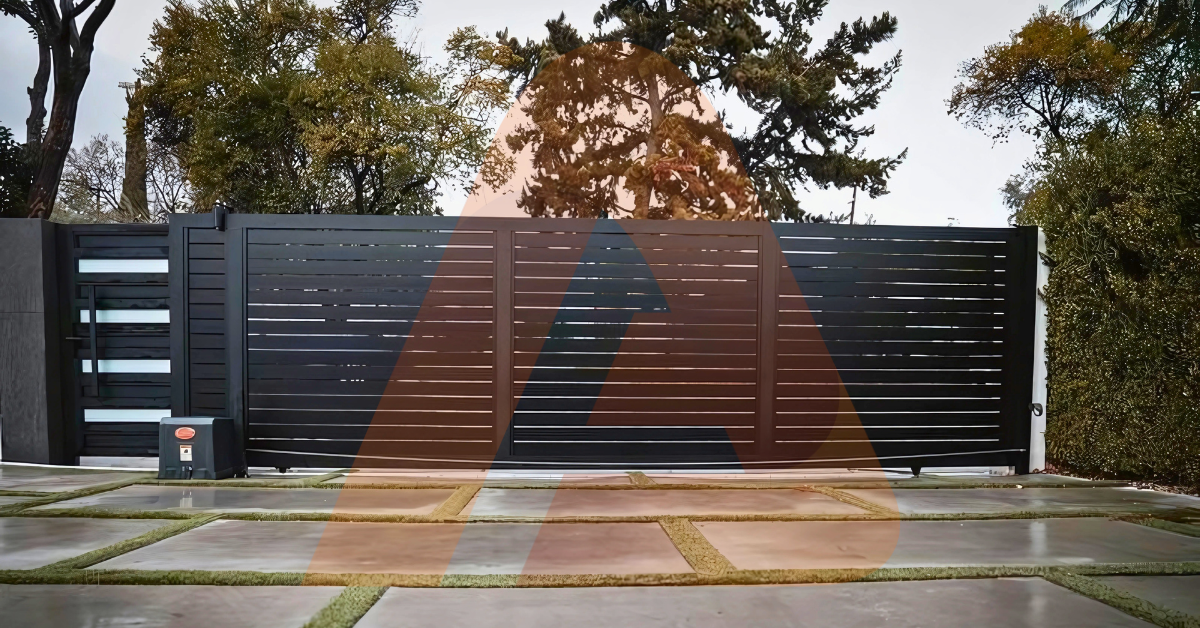
Local Service and Maintenance Options
Chino Hills homeowners benefit from planning both installation and ongoing service together, ensuring Mediterranean-style gates stay smooth, quiet, and elegant through seasonal sun, dust, and occasional winds; it’s wise to line up a responsive local service partner for preventative care, sensor alignment, and quick fixes on operators, hinges, and access systems so the entrance keeps its handcrafted look and reliable daily performance without interruption. A practical plan includes semi-annual inspections for automated systems, quarterly quick-cleaning of photo eyes and lenses during dry months, and an annual finish check with touch-ups around high-contact points like latches and stops to preserve the deep bronze or aged-iron aesthetic over time.
What to look for in a local provider
Fast-response coverage in Chino Hills with experience on Mediterranean motifs, dual-swing synchronization, sliding/cantilever tracks, and discreet operator placement for clean façades.
Preventative maintenance programs that include obstruction-force testing, soft-start/stop tuning, loop and sensor verification, and thorough hinge/bearing lubrication using non-staining products.
Finish-friendly practices, such as pH-neutral cleaning, careful masking for touch-ups, and hardware color-matching so service never compromises the gate’s cohesive look.
Recommended maintenance rhythm
Monthly: Rinse dust, gently clean photo eyes/intercom lenses, and visually check hinge pins, track rollers, and wiring conduits for wear or abrasion.
Quarterly: Lubricate hinges and moving hardware, clear tracks or cantilever rollers, verify safety edges and loop detection, and recheck auto-close timers and schedules.
Semi-annually: Full system tune—operator firmware/settings, soft-start/stop profiles, battery backup test, fastener torque check, and alignment verification on dual leaves.
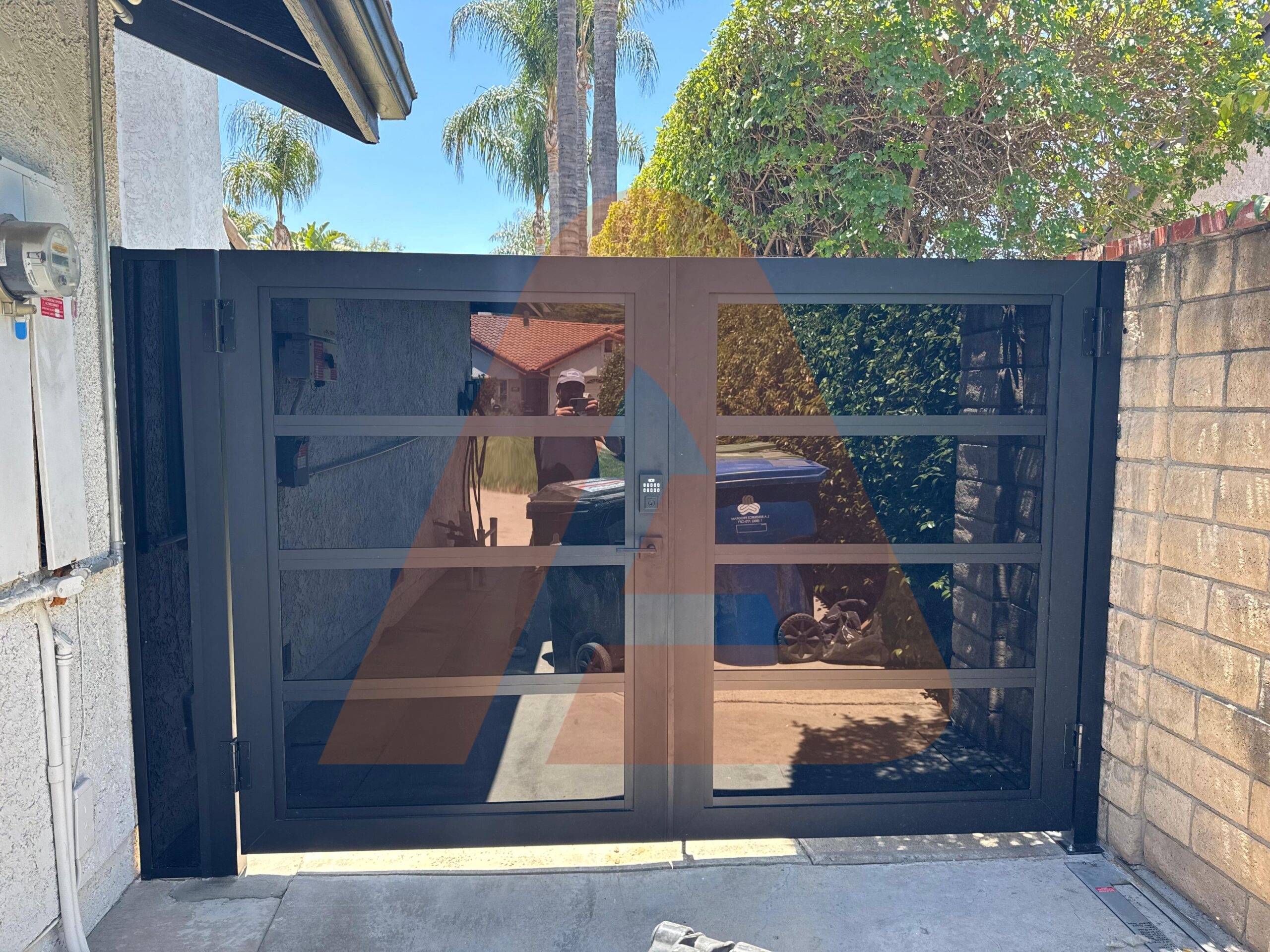
Before-and-After Mediterranean Enhancements
Transforming a standard entry into a Mediterranean showpiece in Chino Hills starts by refining the silhouette and unifying finishes: swapping a flat-top, utilitarian gate for a soft arch-top double-swing immediately echoes arched portals and clay rooflines, while changing glossy paint to a fine-texture matte bronze or aged iron reduces glare and makes scrollwork read as handcrafted, and aligning lanterns, hinges, and visible fasteners to the same tone ties the façade together for a richer curb presence that feels intentional and timeless. Layer in a centered medallion or subtle sunburst rosette, widen the visual “breathing room” between scrolls so patterns cast elegant shadows on stucco at golden hour, and add warm LED grazers at pilasters to reveal depth without hot spots, creating a calm, resort-like arrival that complements terracotta, stone veneers, and wrought-iron balconies commonly found in Mediterranean streetscapes.
High-Impact Upgrades
Replace busy filigree with fewer, larger-radius scrolls and a gentle arch profile so patterns read clearly from the street, then position the densest detailing between 36–60 inches high where the eye naturally lingers during approach for maximum elegance per fabrication hour.
Conceal operators (underground for swing, low-profile for slide), match keypad/intercom housings to the gate finish, and route conduits inside pilasters to remove visual clutter, keeping the composition quiet and authentically Mediterranean.
Curb Appeal Pairings
Gate and façade harmony improves when metal tones repeat on balcony rails and window grilles; pair deep bronze gates with travertine or sandstone pilaster caps and 2700–3000K lanterns to maintain warmth at night, and train bougainvillea or jasmine along side trellises so greenery frames, rather than hides, scrollwork.
On sloped or narrow lots, choose a sliding panel with a shallow eyebrow band and simplified lower-third privacy pickets, finishing hinges, caps, and latches in the same texture so both street and interior views feel consistent and refined.
Final Thoughts
Choosing Mediterranean-inspired gate designs for Chino Hills homes is about uniting graceful arches, balanced scrollwork, and warm, textured finishes with quiet, modern automation so the entrance looks handcrafted yet operates effortlessly; prioritizing proportion, concealed hardware, and UV-stable, fine-texture powder coats ensures the gate remains elegant under bright inland sun and seasonal winds while aligning with stucco, stone, and terracotta elements common to the area’s architecture. Thoughtful planning—design elevations, HOA-friendly palettes, safety-first automation, and a realistic budget with allowances for masonry and power—creates a timeless, resort-like arrival that elevates curb appeal and supports daily convenience for years to come.
Recommended Next Steps
Finalize a motif and arch profile that mirrors your façade, select aluminum or galvanized iron based on weight and maintenance goals, and specify a fine-texture matte bronze or aged iron finish for longevity.
Prepare scaled elevations and a concise submittal packet with operator concealment notes, warm lighting specs, and a safety checklist to streamline HOA review and installation scheduling.
Book a seasonal maintenance rhythm—clean, inspect, lubricate, test—for graceful movement and preserved finishes across the dry summer and mild winter cycles.
Design Your Ideal Fence & Gates Today!
Bring your vision to life with premium aluminum fencing, custom gates, and modern cladding solutions crafted to elevate any property.
Schedule A ConsultationShopFrequently Asked Questions
A soft arch-top double-swing with balanced, larger-radius scrolls and a centered medallion complements arched portals, stucco textures, and terracotta roofs, delivering a handcrafted look that reads clearly from the street without appearing busy.
Aluminum offers corrosion resistance, lighter weight, and smoother automation with fine-texture powder coats that emulate forged iron, while galvanized-and-powder-coated wrought iron provides tactile heft and deeper dimensional detailing at the cost of added weight and maintenance.
Sliding or cantilever designs excel on rising grades and tight setbacks by moving parallel to the fence line, while double-leaf swing gates are ideal where there’s interior clearance and a desire to echo architectural arches; site measurements and slope dictate the right choice.
Look for soft-start/soft-stop, battery backup, photo eyes, safety edges, and app control with discreet, low-profile or underground operators to preserve the Mediterranean aesthetic while ensuring safe, quiet, and reliable daily operation.
Pedestrian gates commonly land in the low-to-mid four figures, non-automated driveway gates in the mid-to-upper four figures, and fully automated double-swing or sliding systems with safety gear, lighting, and pilasters in the low-to-mid five figures, with ornate iron and complex masonry trending higher.


